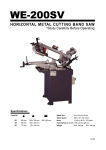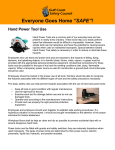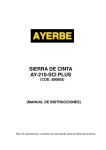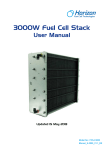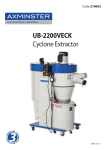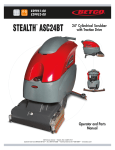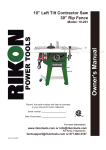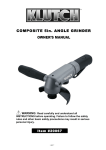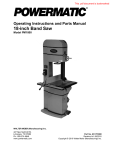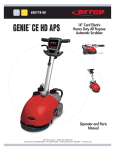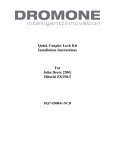Download User Manual - Industrial Tool and Machinery Sales
Transcript
Contents Chapter 6 Chapter 1 ROUTINE AND SPECIAL MAINTENANCE 6.1 Daily Maintenance 6.2 Weekly Maintenance 6.3 Monthly Maintenance 6.4 Six-monthly Maintenance 6.5 Oils for Lubricating Coolant 6.6 Oil Disposal 6.7 Coolant System 6.8 The Gearbox 6.9 Special Maintenance ACCIDENT PREVENTION AND SAFETY REGULATION 1.1 Advice for the Operator 2 1.2 The Electrical Equipment According to 2 European Standard" CENELEC EN 60204-1" 1.3 Emergencies According to European Standard 2 “CENELEC EN 60204-1 Chapter 2 MACHINE DIMENSIONS TRANSPORT INSTALLATION DISMANTLING 2.1 Machine Dimensions 2.2 Transportation of Your Machine 2.3 Minimum Requirements for Housing the Machine 2.4 Position the Machine 2.5 Instructions for Assembly of the Loose Parts and Accessories 2.6 Deactivation of Machine 2.7 Dismantling Chapter 7 2 3 TECHNICAL CHARACTERISTICS 7.1 Table of Cutting Capacity and Technical Details 9 Chapter 8 3 3 MATERIAL CLASSIFICATION AND CHOICE OF TOOL 8.1 Definition of Materials 10 8.2 Selecting Blade 10 8.3 Teeth Pitch 10 8.4 Cutting and Advance Speed 10 10 8.5 Blade Running-in 10 8.6 Blade Structure 10 8.7 Blade Type 3 3 3 Chapter 3 THE MACHINE’S FUNCTIONAL PARTS 3.1 The Saw Bow 3.2 Controls 3.3 Vise Adjustment 3.4 Cutting Angle Adjustment 3.5 The Base 3 3 4 4 4 Chapter 9 NOISE TESTS WIRING DIAGRAM 12 Chapter 11 TROUBLESHOOTING 11.1 - Blade and Cut Diagnosis 4 6 14 Chapter 12 Chapter 5 ADJUSTING YOUR MACHINE 5.1 Blade Tension Assembly 5.2 Aligning the Flywheel 5.3 Checking the Adjustment of the Blade 5.4 Adjusting the Blade Guide 5.5 Changing the Blade 11 Chapter 10 Chapter 4 OPERATING AND ADVICE ON USING YOUR BANDSAW 4.1 The Operation Cycle 4.2 Recommendations for Using the Machine 8 8 8 8 8 8 8 9 9 MACHINE COMPONETS 12.1 Parts List 12.2 Explosion Drawings 6 6 7 7 8 -1- 18 20 1 ACCIDENT PREVENTION AND SAFETY REGULATION This machine has been designed to comply with national and community accident-prevention regulations. Improper use and/or tampering with the safety devices will relieve the manufacturer of all responsibility. 1.1 Advice for the Operator - Check that the voltage indicated on machine motor is the same as the line voltage. - Check the efficiency of your electric supply and grounding system; connect the power cable of the machine to the socket and the ground lead (yellow-green in color) to the grounding system. - When the saw frame is in suspended mode (or raised) the blade must not move. - Only the blade section used for cutting must be kept unprotected. To adjust the blade guards use on the blade guides. - It is forbidden to use the machine without its shields - Always disconnect the machine from the power socket before blade change or carrying out any maintenance job, even in the case of abnormal machine operation. - Always wear suitable eyes protection. - Never put your hands or arms into the cutting area while the machine is operating. - Do not shift the machine while it is cutting. - Do not wear loose clothing like: shirts with sleeves that are too long, gloves that are too big, bracelets, chains or any other object that could get caught in the machine during operation. Tie back long hair. - Keep the area free of equipment, tools, or any other object. - Perform only one operation at a time. Never have several objects in your hands at the same time. Keep your hands as clean as possible. - All internal operations, maintenance or repairs, must be performed in a well-lit area or where there is sufficient light from extra sources so as to avoid the risk of even slight accidents 1.2 The electrical equipment according to European Standard" CENELEC EN 60204-1" - The electrical equipment ensures protection against electric shock as a result of direct or indirect contact. The active parts of this equipment are housed in a box to which access is limited by screws that can only be removed with a special tool; the parts are fed with alternating current as low voltage (24V). The equipment is protected against splashes of water and dust. - Protection of the system against short circuits is ensured by means of rapid fuses and grounding; in the event of a motor overload, protection is provided by a thermal probe. - In the event of a power cut, the specific start-up button must be reset. - The machine has been tested in conformity with point 20 of EN 60204 -2- 1.3 Emergencies according to European Standard “CENELEC EN 60204-1 - In the event of incorrect operation or of danger conditions, the machine may be stopped immediately by pressing the red mushroom button. - The casual or voluntary removal of the protection shield of the flywheels causes the stepping-in of a micro-switch that automatically stops all machine functions. NOTE: Resetting of machine operation after each emergency stop requires specific restart button. 2 MACHINE DIMENSIONS TRANSPORT INSTALLATION DISMANTLING 2.1 Machine Dimensions 2) Electrical components, including the cable and electronic material (magnetic cards, etc.), fall within the category of material classified as being assimilated to urban waste according to the laws of your local, state, or federal government, so they may be set aside for collection by the public waste disposal service; 3) Old mineral and synthetic and/or mixed oils, emulsified oils and greases are considered hazardous or special refuse, so they must be collected, transported and disposed of at a special waste disposal service. 2.2 Transportation of Your Machine NOTE: The standards and legislation concerning refuse is in a constant state of evolution, therefore is subject to changes. The user must keep informed of the regulations at the time of disposal as these may differ from those described above. To move the machine, the machine needs to be moved in its own packing, use a forklift truck to move it. 3 THE MACHINE’S FUNCTIONAL PARTS 2.3 Minimum Requirements for Housing the Machine - Main voltage and frequency must comply with the machine’s motor requirements. - Environment temperature should fall within –10 ºC to +50 ºC. - Relative humidity cannot be over 90%. 3.1 The Saw Bow The saw bow is a collection of machine parts consisting of a saw bow, drive members (gears transfer, motor, blade wheel), blade tension system, blade guides, and blade guards. The WP-210SH model also includes a hydraulic cylinder and adjustable counter-balance spring. 2.4 Position the Machine Position the machine on a firm cement floor, maintaining, at the rear, a minimum distance of 800 mm from the wall; ensuring it is sitting on level. 2.5 Instructions for Assembly of the Loose Parts and Accessories Fit the components supplied: Detail 1 Mount bar-stop rod Detail 2 Mount and align the roll-supporting arm as per the vise table. 2.6 Deactivation of Machine - If the sawing machine is to be out of use for a long period, it is advisable to proceed as follows: 1) Detach the plug from the electric supply panel 2) Loosen blade 3) Release the saw bow’s counter-balance spring 4) Empty the coolant tank 5) Carefully clean and grease the machine 6) If necessary, cover the machine. 3.2 Controls For model WP-210S A 2.7 Dismantling (due to deterioration and/or obsolescence) B D General rules If the machine is to be permanently demolished and/or scrapped, divide the material to be disposed of according to type and composition, as follows: 1) Non-composite cast iron or ferrous materials are recyclable raw materials, so they may be taken to an iron foundry for re-smelting after having removed the contents (classified in point 3). A. B. D. E. -3- Main Connect Switch Power Indicator Light Emergency Push Button ON/OFF Trigger and Control Handle E For model WP-210SH 3.4 Cutting Angle Adjustment A I D B F Cutting at angles - Angle can be cut up to 60 - Unlock lever (I) by pushing it to the left side. - Rotate the saw bow to the desired angle by following the index on the scale. - Lock lever (I) by pushing to the right side. C 3.5 The Base The base is a structure supporting the saw bow, the vise, the bar stop, the work piece supporter, pump, swing arm, and the coolant return plate for the support of the material. The base houses the cooling liquid tank. E A. B. C. D. E. F. Main Connect Switch Power Indicator Light Start Cutting Push Button Emergency Push Button ON/OFF Trigger and Control Handle Manual or Hydraulic Operation Selector 3.3 Vise Adjustment 4 OPERATING AND ADVICE ON USING YOUR BANDSAW H 4.1 The Operation Cycle Before operating the machine, all the main parts of the machine must be set to the optimum conditions. G Power and blade speed select switch Clamping the Work Piece - Place the work piece between the vise jaws and have it rest next to the fixed vise jaw. - Rotate the hand wheel (G) clockwise to close the free vise jaw on to the work piece, and tighten. - Rotate the hand wheel (G) counter-clockwise to release. - Lever (H) can be used to rapidly lock and release the work piece by allowing a shallow gap between the vise and work piece. Then rotate lever (H) counter-clockwise to lock and clockwise to release. Their are three positions can be selected, Off, Rabbit or Turtle on the main switch, if select blade speed must be exactly turned towards Rabbit or Turtle sign in cutting situation. -4- - Reduce the bow weight. Rotate the wing nut (K) clockwise to increase the tension on the spring. - Load work piece and clamp it properly. - Turn on main connect switch (A) to the ON position. Check to see that the indicator light (B) is lit. - Select manual control mode. Turn the control switch (F) to manual control mode for trigger operation. - Hold the control handle (E) of the saw bow. - Fully open the flow control knob (J) by rotating counter-clockwise to the maximum, and open the on/off hydraulic switch (V).to on position.. - Squeeze the trigger on the control handle (E) to start the blade and lower saw bow to begin cutting. - When the saw bow reaches the bottom the micro-switch will activate and the blade will stop. - Keep hold of the control handle to control the return to the start position. - Close the hydraulic regulation lever (V). - The cutting operation is complete. Reset the work piece to continue the next cutting cycle. E The WP-210S is equipped with manually trigger handle switch E. 1. Manual Operation of 210S A B G D 3. Semi-auto Cutting Operation of 210SH - Saw head return spring (G) has been set in factory. - Load work piece and clamp it properly. - Check to see that the indicator light (B) is lit. - Hold the control handle (E) of the saw bow. - Squeeze the trigger on the control handle (E) to start the blade and lower saw bow to begin cutting. - When the saw bow reaches the bottom, release the trigger switch the blade will stop. - Keep hold of the control handle to control the return to the start position. - The cutting operation is complete. Reset the work piece to continue the next cutting cycle. K J V If may has an emergency situation should occur. - Press the emergency push button (D) down to shut off all functions. To release the emergency pushbutton rotate the mushroom shaped button in the clock-wise direction. The button will pop up, then the cutting cycle can be restarted. ! ! WARNING Failure to fully close the hydraulic flow control knob (J) and locking the hydraulic regulation lever (V) can result in serious injury. The saw bow may drop suddenly when changing the spring tension. 2. Manual Operation of 210SH - Close the hydraulic regulation lever (V) by switching it clockwise. - Increase the bow weight. Rotate the wing nut (K) counter clockwise to reduce the spring tension. - Load work piece and clamp it properly. - Turn main connect switch (A) to the ON position. Check to see that the indicator light (B) is lit. - Select Hydraulic mode on control switch (F), turn the switch to the right. - Press the start button (C). The coolant system should activate at the same time. - Open the hydraulic regulation lever (V) by switching it counter-clockwise. K J V D -5- and check that the blade or its teeth are not broken. If they are broken, change the tool. - Before carrying out any repairs on the machine, consult the dealer. - Slightly turn the hydraulic flow control knob (J) counter-clockwise from 2-3 to control the saw bow’s descent rate. - When the saw bow reaches the bottom the micro-switch will activate and the blade will stop. - Lift the saw bow to the appropriate height close the hydraulic regulation lever (V) by rotating it clockwise all the way to the end. - The machine is now ready for the next cutting operation. 5 ADJUSTING YOUR MACHINE 5.1 Blade Tension Assembly Blade tension is important to the proper operation of the saw. Proper blade tension is 700 to 900 kg/mm2 as measured on a blade tension gauge. If may has an emergency situation should occur. - Press the emergency push button (D) down to shut off all functions. To release the emergency pushbutton rotate the mushroom shaped button in the clock-wise direction. The button will pop up, then the cutting cycle can be restarted. L 4.2 Recommendations for Using the Machine The machine has been designed to cut metal building materials, with different shapes and profiles, used in workshops, turner's shops and general mechanical structural work. Only one operator is needed to use the machine, that must stand as shown in the picture. - Before starting each cutting operation, ensure that the part is firmly clamped in the vise and that the end is suitably supported. - These figures below show examples of suitable clamping of different section bars, bearing in mind the cutting capacities of the machine in order to achieve a good efficiency and blade durability. To set the blade tension without the use of a tension gauge: - Disconnect the machine from the power source. - Install blade between wheel and insert blade between bearings on blade guides. - Tension blade slightly to remove any sag in blade between blade wheels. - Turn blade tension knob (L) one and three quarter to two revolutions clockwise. To test press the flat side of the blade with your thumb, if moves with 2mm-3mm range then it is set correctly. - After blade has been completely installed, close covers, connect the power source, and run saw for two to three minutes so blade can seat properly. - Disconnect machine from the power source. Open cover and loosen blade just until it begins to sag. - Tighten blade until it becomes straight between blade wheel and all sag has been eliminated. - Tighten blade by turning blade tension wheel two full revolutions. Blade is now property tensioned and ready for use. Close covers and connect machine to the power source. 5.2 Aligning the Flywheel The flywheel’s alignment may need adjustment to allow the saw blade to track correctly. Poor flywheel alignment can cause damage to the saw blade or to allow the blade to ride off the blade wheels. - Do not use blades of a different size from those stated in the machine specifications. - If the blade gets stuck in the cut, release the running but ton immediately, switch off the machine, open the vise slowly, remove the part -6- 5.4 Adjusting the Blade Guide M N O - Disconnect the machine from the power source. - Release the extension bar for the blade guide block. Use the hex socket screw (N) to loosen the clamping block (O). - Hold the revolving handle (M) and slide the blade guide block to be as close as possible to the material without interfering with the cut. - Tighten the hex socket screw (N). - Reconnect the machine to power source. Raise the saw bow to a usable work height. Disconnect the power supply. Loosen the Hex nut screws A, B, and C. Use and Allen wrench on setscrew D to adjust the tilt of the flywheel. - Turning the setscrew, D clockwise will tilt flywheel so that the blade will ride closer to the flange. - Turning the setscrew, D counter-clockwise will tilt the flywheel so that the blade will ride away from the flange. If the blade rides too far then it will come off. - After the adjustment is finish, fasten the Hex nut screws in this order: A, B, and C. - Blade Guide Blocks The blade is guided by means of roller bearings placed during inspection as per the thickness of the blade with a minimum amount of play. In case the blade needs to be replaced, make sure to always install 0.9mm thick blades for which the blade guide bearing have been adjusted. In the case of toothed blades with different thicknesses adjustment should be carried out as follows: - From the bottom of the guide blocks, use a wrench on the adjusting nut of the eccentric bearing. - Turning the adjusting nut clockwise will move the eccentric bearing away from the blade. - Turning the adjusting nut counter-clockwise will move the eccentric bearing closer to the blade. 5.3 Checking the Adjustment of the Blade Use a strip of scrap paper and slide it between the blade and the flywheel while it is running. - If the paper is cut then the blade is riding too close to the flange. Readjust. - If the paper folds or creases then the blade is seated properly. - If you notice that the blade is riding away from the flange, then readjust. BEFORE PERFORMING THE FOLLOWING OPERATIONS, THE ELECTRIC POWER SUPPLY AND THE POWER CABLE MUST BE COMPLETELY DISCONNECTED. -7- - Rise of saw frame to top position and partial slackening of the blade to avoid useless yield stress. - Check functionality of the shields and emergency stops. 5.5 Changing the Blade N 6.2 Weekly Maintenance - Thorough cleaning of the machine to remove shavings, especially from the lubricant fluid tank. - Removal of pump from its housing, cleaning of the suction filter and suction zone. - Clean the filter of the pump suction head and the suction area. - Use compressed air to clean the blade guides (guide bearings and drain hole of the lubricating cooling). - Cleaning flywheel housings and blade sliding surfaces on flywheels. To change the blade: - Lift the saw bow. - Loosen the blade with the blade tension hand wheel, remove the mobile blade-guard cover, open the flywheel guards and remove the old blade from the flywheels and the blade guide blocks. - Assemble the new blade by placing it first between the pads and then on the race of the flywheels, paying particular attention to the cutting direction of the teeth. - Tension the blade and make sure it perfectly fits inside the seat of the flywheels. - Assemble the mobile blade-guide end, the flywheel guard, and fasten it with the relative knobs. Check the safety micro-switch (N) is activated otherwise when electricity is applied the machine will not start. 6.3 Monthly Maintenance - Check the tightening of the motor flywheel screws. - Check that the blade guide bearings on the heads are perfect running condition. - Check the tightening of the screws of the gear motor, pump, and accident protection guarding. 6.4 Six-Monthly Maintenance - Continuity test of the equipment potential protection circuit. 6.5 Oils for Lubricating Coolant Considering the vast range of products on the market, the user can choose the one most suited to their own requirements, using as reference the type SHELL LUTEM OIL ECO. THE MINIMUM PERCENTAGE OF OIL DILUTED IN WATER IS 8 10 %. BLADE CUTTING DIRECTION 6.6 Oil Disposal The disposal of these products is controlled by strict regulations. Please see the Chapter on "Machine dimensions Transport - Installation" in the section on Dismantling. WARNING: Always assemble blades having dimensions specified in this manual and for which the blade guide heads have been set; otherwise, see chapter on "Description of the operating cycle" in the section Starting-up. 6.7 Coolant system 6 ROUTINE AND SPECIAL MAINTENANCE P THE MAINTENANCE JOBS ARE LISTED BELOW, DIVIDED INTO DAILY, WEEKLY, MONTHLY AND SIX-MONTHLY INTERVALS. IF THE FOLLOWING OPERATIONS ARE NEGLECTED, THE RESULT WILL BE PREMATURE WEAR OF THE MACHINE AND POOR PERFORMANCE. Q Cleaning the tank - Use hex wrench to open the plug located on the base below the pump. Allow the coolant to drain-out. - Remove the grate (P) by loosening the four setscrews. - Remove the pump (Q) by loosening the four setscrews. 6.1 Daily maintenance - General cleaning of the machine to remove accumulated shavings. - Clean the lubricating coolant drain hole to avoid excess fluid. - Top off the level of lubricating coolant. - Check blade for wear. -8- - Use a vacuum cleaner to vacuum chips and debris from the tank. Replace the plug. Thoroughly clean the pump (Q) and replace. Fill the tank with coolant to approximately 25mm below the grate (P). Replace the grate (P). 6.9 Special Maintenance Special maintenance must be conducted by skilled personnel. We advise contacting your nearest dealer and/or importer. Also the reset of protective and safety equipment and devices (of the reducer), the motor, the motor pump, and other electrical components requires special maintenance. 6.8 The Gearbox 7 TECHNICAL CHARACTERISTICS R 7.1 Table of Cutting Capacity and Technical Details S The gearbox requires periodic changing of oil. The oil must be changed by the first six months of a new machine and every year thereafter. To change the gear box oil - Disconnect the machine from the power source. - Raise the saw bow to vertical position. - Release the drain hole (S) to draw off gear oil by loosening the oil fill bolt (R). - Replace the drain plug bolt (S) after oil completely flows off. - Place the saw bow back to horizontal position. - Fill Gear box with approximately .3 liter of gear oil through the hole of the oil fill bolt (R). For reference, use SHELL type gear oil or Mobile gear oil #90. BLADE MOTOR kW 0.75 BLADE SIZE mm 20x0.9x2110 m/min 90 / 45 mm 890 kg 156 BLADE SPEED WORKING TABLE HEIGHT MACHINE WEIGHT -9- 8 MATERIAL CLASSIFICATIONS AND CHOICE OF TOOL Since the aim is to obtain excellent cutting quality, the various parameters such as hardness of the material, shape and thickness, transverse cutting section of the part to be cut, selection of the type of cutting blade, cutting speed and control of saw frame lowering. These specifications must therefore be harmoniously combined in a single operating condition according to practical considerations and common sense, so as to achieve an optimum condition that does not require countless operations to prepare the machine when there are many variations in the job to be performed. The various problems that crop up from time to time will be solved more easily if the operator has a good knowledge of these specifications. 8.4 Cutting and advance speed The cutting speed (m/min) and the advance speed (cm2/min =area traveled by the disk teeth when removing shavings) are limited by the development of heat close to the tips of the teeth. - The cutting speed is subordinate to the resistance of the material (R = N/mm2), to its hardness (HRC) and to the dimensions of the widest section. - Too high an advance speed (= lowering of the saw frame) tends to cause the disk to deviate from the ideal cutting path, producing non rectilinear cuts on bath the vertical and the horizontal plane. 8.1 Definition of materials The table above lists the characteristics of the materials to be cut. So that the correct tools to use, can be chosen. The best combination of these two parameters can be seen directly examining the chips. 8.2 Selecting blade First of all the pitch of the teeth must be chosen, in other words, the number of teeth per inch (25,4 mm) suitable for the material to be cut, according to these criteria: - Parts with a thin and/or variable section such as profiles, pipes and plate, need fine tooth, so that the number of teeth used simultaneously in cutting is from 3 to 6; - Parts with large transverse sections and solid sections need coarse tooth to allow for the greater volume of the shavings and better tooth penetration; - Parts made of soft material or plastic (light alloys, mild bronze, Teflon, wood, etc.) also require widely spaced tooth. - Pieces cut in bundles require combo tooth design. 8.3 Teeth pitch As already stated, this depends on the following factors: - Hardness of the material - Dimensions of the section - Wall thickness. Long spiral-shaped chips indicate ideal cutting. Very fine or pulverized chips indicate lack of feed and/or cutting pressure. Thick and/or blue chips indicate overload of the blade. 8.5 Blade running-in When cutting for the first time, it is good practice to run in the tool making a series of cuts at a low advance speed (= 30-35 cm2/min on material of average dimensions with respect to the cutting capacity and solid section of normal steel with R = 410-510 N/mm2). Generously spraying the cutting area with lubricating coolant. 8.6 Blade structure Bi-metal blades are the most commonly used. They consist of a silicon-steel blade backing by a laser welded high-speed steel (HHS) cutting edge. The type of stocks are classified in M2, M42, M51 and differ from each other because of their major hardness due to the increasing percentage of Cobalt (Cc) and molybdenum (Mo) contained in the metal alloy 8.7 Blade type They differ essentially in their constructive characteristics, such as: - Shape and cutting angle of tooth - Pitch - Set Shape and angle of tooth REGULAR TOOTH: Oº rake and constant pitch. - 10 - for the cutting of solid bars at maximum machine capacity. Available pitches: 3-4/4-6. SETS Saw teeth bent out of the plane of the saw body, resulting in a wide cut in the workpiece. Most common form for transversal or inclined cutting of solid small and average cross-sections or pipes, in laminated mild steel and gray iron or general metal. POSITIVE RAKE TOOTH: 9º - 10º positive rake and constant pitch. REGULAR OR RAKER SET: Cutting teeth right and left, alternated by a straight tooth. Of general use for materials with dimensions superior to 5 mm. Used for the cutting of steel, castings and hard nonferrous materials. Particular use for crosswise or inclined cuts in solid sections or large pipes, but above all harder materials (highly alloyed and stainless steels, special bronze and forge pig iron). WAVY SET: Set in smooth waves. COMBO TOOTH: pitch varies between teeth and consequently varying teeth size and varying gullet depths. Pitch varies between teeth, which ensures a smoother, quieter cut and longer blade life owing to the lack of vibration. This set is associated with very fine teeth and it is mainly used for the cutting of pipes and thin section bars (from 1 to 3 mm). ALTERNATE SET (IN GROUPS): Groups of cutting teeth right and left, alternated by a straight tooth. Another advantage offered in the use of this type of blade in the fact that with an only blade it is possible to cut a wide range of different materials in size and type. This set is associated with very fine teeth and it is used for extremely thin materials (less than 1mm). ALTERNATE SET (INDIVIDUAL TEETH): Cutting teeth right and left. COMBO TOOTH: 9º - 10º positive rake. This set is used for the cutting of nonferrous soft materials, plastics and wood. This type of blade is the most suitable for the cutting of section bars and large and thick pipes as well as 9 NOISE TESTS The test was held under environmental noise levels of 65db. Noise measurements with the machine operating unload was 71db. Noise level during the cutting of mild carbon steel was 73db. NOTE: with the machine operating, the noise level will vary according to the different materials being processed. The user must therefore assess the intensity and if necessary provide the operators with the necessary personal protection, as required by Law 277/1991. - 11 - 10 WIRING DIAGRAMS Model WP-210S - 12 - Model WP-210SH - 13 - 11 TROUBLESHOOTING This chapter lists the probable faults and malfunctions that could occur while the machine is being used and suggests possible remedies for solving them. 11.1 Blade and cut diagnosis FAULT TOOTH BREAKAGE PROBABLE CAUSE REMEDY Too fast advance Decrease advance, exerting less cutting pressure. Adjust the braking device. Wrong cutting speed Change speed and/or type of blade. See chapter on "Material classification and blade selection", in the section Blade selection table according to cutting and feed speed. Wrong tooth pitch Choose a suitable blade. See Chapter "Material classification and blade selection". Chips sticking onto teeth and in the gullets or material that gums Check for clogging of coolant drain holes on the blade-guide blocks and that flow is plentiful in order to facilitate the removal of chips from the blade. Defects on the material or material too hard Material surfaces can be oxidized or covered with impurities making them, at the beginning of the cut, harder that the blade itself, or have hardened areas or inclusions inside the section due to productive agents used such as casting sand, welding wastes, etc. Avoid cutting these materials or in a situation a cut has to be made use extreme care, cleaning and remove any such impurities as quickly as possible. Ineffective gripping of the part in the vise Check the gripping of the part. The blade gets stuck in the material Reduce feed and exert less cutting pressure. Starting cut on sharp or irregular section bars Pay more attention when you start cutting. Poor quality blade Use a superior quality blade. Previously broken tooth left in the cut Accurately remove all the parts left in. Cutting resumed on a groove made previously Make the cut elsewhere, turning the part. Vibrations Check gripping of the part. Wrong tooth pitch or shape Replace blade with a more suitable one. See "Material classification and blade selection" in the Blade Types section. Adjust blade guide pads. Insufficient lubricating, refrigerant, or wrong emulsion Check level of liquid in the tank. Increase the flow of lubricating refrigerant, checking that the hole and the liquid outlet pipe are not blocked. Check the emulsion percentage. Teeth positioned in the direction opposite the cutting direction Turn teeth to correct direction. - 14 - FAULT PREMATURE BLADE WEAR BLADE BREAKAGE PROBABLE CAUSE REMEDY Faulty running-in of blade See "Material classification and blade selection" in the Blade running-in section. Teeth positioned in the direction opposite the cutting direction Turn teeth in correct direction. Poor quality blade Use a superior quality blade. Too fast advance Decrease advance, exerting less cutting pressure. Adjust the braking device. Wrong cutting speed Change speed and/or type of blade. See chapter on "Material classification and blade selection,” in the section Blade selection table according to cutting and feed speed. Defects on the material or material too hard Material surfaces can be oxidized or covered with impurities making them, at the beginning of the cut, harder that the blade itself, or have hardened areas or inclusions inside the section due to productive agents used such as casting sand, welding wastes, etc. Avoid cutting these materials or perform cutting with extreme care, cleaning and remove such impurities as quickly as possible. Insufficient lubricating refrigerant or wrong emulsion Check level of liquid in the tank. Increase the flow of lubricating coolant, checking that the coolant nozzle and pipe are not blocked. Check the emulsion percentage. Faulty welding of blade The welding of the blade is of utmost importance. The meeting surfaces must perfectly match and once they are welded they must have no inclusions or bubbles; the welded part must be perfectly smooth and even. They must be evenly thick and have no bulges that can cause dents or instant breakage when sliding between the blade guide pads. Too fast advance Decrease advance, exerting less cutting pressure. Adjust the braking device. Wrong cutting speed Change speed and/or type of blade. Wrong tooth pitch See chapter on "Material classification and blade selection", in the section Blade selection table according to cutting and feed speed. Ineffective gripping of the part in the vice Choose a suitable blade. See Chapter "Material classification and blade selection.” Blade touching material at beginning of cut Check the gripping of the part. Remedy At the beginning of the cutting process, never lower the saw bow before starting the blade motor. - 15 - FAULT PROBABLE CAUSE REMEDY Blade guide pads not regulated or dirty because of lack of maintenance Check distance between pads (see "Machine adjustments" in the Blade Guide Blocks section): extremely accurate guiding may cause cracks and breakage of the tooth. Use extreme care when cleaning. Blade guide block too far from material to be cut Approach head as near as possible to material to be cut so that only the blade section employed in the cut is free, this will prevent deflections that would excessively stress the blade. Improper position of blade on flywheels The back of blade rubs against the support due to deformed or poorly welded bands (tapered), causing cracks and swelling of the back contour. Insufficient lubricating coolant or wrong emulsion Check level of liquid in the tank. Increase the flow of lubricating refrigerant, checking that the hole and the liquid outlet pipe are not blocked. Check the emulsion percentage. STEAKED OR ETCHED BANDS Damaged or chipped blade guide pads Replace them. Tight or slackened blade guide bearings. Adjust them (see Chapter "Machine adjustments" in Blade guide section). CUTS OFF THE STRAIGHT Blade not parallel as to the counter service Check fastenings of the blade guide blocks as to the counter-vice so that they are not too loose and adjust blocks vertically; bring into line the position of the degrees and if necessary adjust the stop screws of the degree cuts. Blade not perpendicular due to the excessive play between the guide pads and maladjustment of the blocks Check and vertically re-adjust the blade guide blocks; reset proper side guide play (see Chapter "Machine adjustments" In Blade guide section). Too fast advance Decrease advance, exerting less cutting pressure. Adjust the braking device. Worn out blade Approach it as near as possible to material to be cut so that only the blade section employed in the cut is free, this will prevent deflections that would excessively stress the blade. Wrong tooth pitch Replace it. Blade with major density of teeth is being used, try using one with less teeth (see Chapter "Material classification and blade selection" in the Blade Types section). - 16 - FAULT PROBABLE CAUSE REMEDY Broken teeth Irregular work of the blade due to the lack of teeth can cause deflection in the cut; check blade and if necessary replace it. Insufficient lubricating refrigerant or wrong emulsion Check level of liquid in the tank. Increase the flow of lubricating coolant, checking that the hole and the liquid outlet pipe are not blocked. Check the emulsion percentage. FAULTY CUT Worn out flywheels Flywheel housing full of chips The support and guide flange of the band are so worn out that they cannot ensure the alignment of the blade, causing faulty cutting; blade rolling and drawing tracks can have become tapered. Replace them. Clean with compressed air. STREAKED CUTTING SURFACE Too fast advance Decrease advance, exerting less cutting pressure. Adjust the braking device. Poor quality blade Use a superior quality blade. Worn out blade or with chipped and/or broken teeth Replace it. Wrong tooth pitch Blade used probably has too large teeth, use one with more teeth (see "Material classification and blade selection" in the Blade Types section). Blade guide block too far from material to be cut Approach it as near as possible to material to be cut so that only the blade section employed in the cut is free, this will prevent deflections that would excessively stress the blade. Insufficient lubricating coolant or wrong emulsion Check level of liquid in the tank. Increase the flow of lubricating coolant, checking that the hole and the liquid outlet pipe are not blocked. Check the emulsion percentage. Chipped bearings Worn out or damaged pads Dirt and/or chips between blade and guide bearings. Replace them. Replace them. NOISE ON GUIDE BLOCKS - 17 - PART Part No. Description Size No. Q’ty LIS T Part No. Description Size No. Q’ty 1 Base (Right Part) 1 55 Set Screw M8x10 1 1-1 Base (Left Part) 1 56 Nut M20 1 2 Hex. Cap Bolt M12x40 2 56-1 Set Screw M5x5 3 Nut M12 2 57 Bearing Bushing 4 Base Cover Plate 2 58 Ball Bearing 5 Hex. Cap Bolt M8x16 8 59 Lock Handle 1 6 Flat Washer M8x18x2 16 60 Bushing 1 7 Nut M8 8 61 Hex. Socket Cap Screw 8 Flat Washer M10x21x2 2 62 Movable Vise 1 9 Spring Washer M10 2 63 Compressed Spring 1 10 Hex. Socket Cap Screw M10x20 2 64 Lead Screw 1 11 Hex. Socket Cap Screw M6x8 12 Plate 13 Hex. Socket Cap Screw 14 Spring Washer 15 1 1 #51104 M6x100x28 1 2 2 64-1 Key 5x5x15 1 1 64-2 Flat Washer M8 1 M8x20 2 64-3 Hex. Socket Cap Screw M8x16 M8 2 66 Vise Table Hex. Socket Cap Screw M8x20 2 67 Set Screw M8x10 1 15-1 Spring Washer M8 2 68 Hex. Socket Cap Screw M5x8 2 16 Flat Washer M8x18x2 2 69 Scale Point 17 Supporting Plate 1 70 Set Screw 18 Nut M8 2 71 Pivot 18-1 Flat Washer M8x18x2 19-1 Support Plate 19-2 Hex. Cap Bolt 19-3 Spring Washer 19-4 Flat Washer M10x21x2 28 Block Plate 31 Hex. Cap Bolt 32 Nut 33 Filter Net 34 Round Head Screw 35 Hex. Socket Cap Screw 36 Flat Washer 37 Hose 38 39 40 Plug 41 Coolant and Chip Tray 42 Locking Lever 43 Set Screw 44 Spring Washer 45 Hex. Socket Cap Screw M10x35 46 Nut 47 Shaft 48 Oil Seal 50 Disk 51 Spring Washer M8 52 Hex. Socket Cap Screw M8x30 53 Set Screw 54 Hand Wheel 1 1 1 M8x10 1 1 2 72 Anti-Bust Cover Ø30 2 1 73 Ball Bearing #32006 2 M10x20 2 74 Nut M10 2 M10 2 75 Hex. Cap Bolt M10x40 1 2 75-1 Hex. Cap Bolt M10x25 1 76 Spring Hook M12x40 2 77 Star Washer Ø30 M12 2 78 Nut M30 1 79 Swing Arm M5x10 4 80 Scale M6x25 2 81 Rivet M6 2 82 Bar-Stop-Rod 1 5/16”x125cm 1 83 Rod 1 Hose Clamp 1 84 Butterfly Screw 5/16x3/4 1 Pump 1 85 Main Connect Switch 3PH 1 1 85-1 0-1 Power Switch (not shown) 1PH 1 1 86 Emergency Switch 1 1 87 Power Indicator Light 1 M10x16 1 88H Manual / Auto Selector 1 M10 1 89H Start Button 1 1 90H PVC Panel 1 1 90 PVC Panel 1 1 90-1 Plastic Box 1 1 91 Fuse Seat 1 1 92 Transformer 1 4 93 Overload Relay 1 4 94 Magnetic Connector 1 M8x10 1 95 Control Bracket 5-1/2” 1 95-1 Round Head Screw M3/8” 4m/m(51.7-52cm) 1 1 1 1 1 1 2.3x4 2 1 M5x10 8 981005 - 18 - PART Part No. Description Size No. 96 Setting Bracket 97 Spring Washer M8 98 Hex. Socket Cap Screw 99 Spring Washer 100 Hex. Socket Cap Screw 103 Front Ball Bearing Bracket 104 Setting Bracket 105 Handle 106 Hex. Socket Cap Screw 107 Plastic Handle 108 Spring Washer 109 Hex. Socket Cap Screw 110 Set Screw 114 Rod 115 Nut M16x2 Q’ty LIS T Part No. Description Size No. 1/4Px5/16 Q’ty 1 150 Coolant Switch 2 150-1 Brace 1 M8x20 2 150-2 Hex. Socket Cap Screw M8 4 151 Hose Clamp M8x20 4 152 Hose 1 153 Limit Switch 1 1 153-1 Switch Pin 1 M10x45 1 154 Hex. Socket Cap Screw M6x8 1 155 Spring Shaft M6 1 155-H1 Spring Shaft 1 M8 3 155-H2 Setting Plate 1 M8x25 3 155-H3 Handle M8x30 2 155-H4 Nut 1 155-H5 Bushing 1 1 155-H6 Adjustable Shaft 1 1 M6x12 2 1 5/16”x35cm M4x35 1 2 1 1 M16x2.0x8t 2 116 Trigger Switch 1 155-H7 Spring 117 Cover Plate 1 155-H8 Set Screw 118 Hex. Socket Cap Screw M6x8 2 156 Spring 119 Set Screw M10x25 1 157 Key 120 Hex. Socket Cap Screw M10x40 3 158 Gear Box 121 Spring Washer M10 3 159 Key 122A Slide 1 160 Motor 123 Nut 1 161 Spring Washer M8 4 124 Handle 2 162 Hex. Cap Bolt M8x25 4 125 Handle Wheel 1 163 Set Screw M6x12 4 126 Thrust Spring Washer 8 170 Set Screw M6x12 4 127 Tension Shaft 1 172 Hex. Socket Cap Screw M8x25 2 128A Shaft 129 Ball Bearing 8 130 131 132 Spring Washer 133 Hex. Cap Bolt 134A Blade 135 Knob Bolt 136A Blade Cover 137 Round Head Screw M4x8 138-1 Nut M4 139 Hex. Cap Bolt 140 Spring Washer 141 142 143 Hex. Socket Cap Screw 144 Spring Washer M16x2 1 M8x10 3 1 7x7x25 1 1 5x5x25 1 1 1 173 Centric Shaft 2 174 Ball Bearing #608ZZ Idle Flywheel 1 175 E Ring E7 Washer 1 176 Eccentric Shaft 2 M10 1 177 Front Ball Bearing Seat 1 M10x25 1 178 Front Blade Guard 1 1 179 Hex. Socket Cap Screw M6x8 1 M6x10 4 180 Hex. Socket Cap Screw M8x20 2 1 181 Ball Bearing #608ZZ 2 2 182 Spring Washer M8 2 2 183 Pipe Fitting 1/4Px5/16 2 M10x25 1 184 Nut M8 4 M10 1 185 Spring Washer M8 4 Washer 1 186 Rear Ball Bearing Seat Drive Flywheel 1 188 Hex. Socket Cap Screw M8x25 2 M8x35 4 189 Rear Blade Guard M8 4 190 Round Head Screw M6x8 2 #6006ZZ 145A Saw Arm 145-1 Set Shaft 146 Hose 5/16”x75cm 1 147 Pipe Fitting 1/4Px5/16 2 148A Pipe Fitting Seat 2 4 1 1 1 1 1 981005 - 19 - - 20 - 5(8) 6(16) 7(8) 4(2) 1-1 WP-210S/SH 3(2) 2(2) 1 19-2(2) 19-3(2) 19-4(2) 19-1 12 13(2) 14(2) 16(2) 15-1(2) 15(2) 17 11(2) 18(2) 18-1(2) 28 10(2) 9(2) 8(2) 31(2) 33 32(2) 34(4) 40 35(2) 36(2) 981005-V1 41 39 38 37 - 21 - 54 55 56 56-1 WP-210S/SH 57 58 59 53 60 63 62 61(2) 64 64-1 42 64-3 64-2 47 46 45 44 43 48 50 52(4) 51(4) 75-1 66 71 70 79 80 81(2) 74(2) 72(2) 73(2) 69 75 77 76 78 68(2) 67 86 87 85 87 88H 86 85 90 WP-210S 89H 83 91 90-1 90H WP-210SH 82 94 95-1(8) 99(4) 100(4) 92 93 84 95 981005-V1 96 97(2) 98(2) - 22 - 125 123 126(8) 134A 124(2) 135(4) 136A WP-210S/SH 122A 127 121(3) 120(3) 119 116 130 129(2) 118(2) 117 133 132 131 115 114 128A 110(2) 145A 146 147(2) 108(3) 109(3) 144(4) 143(4) 139 140 141 142 138-1(2) 137(2) (153-1) 153 148A 107 106 (72) 145-1 154(2) 105 104 103 WP-210S 152 150-2(2) 150 151 (37) 150-1 157 156 155 155H-8(3) 158 155H-6 155H-2 WP-210SH 160 981005-V1 155H-3 155H-4(2) 155H-5 161(4) 162(4) 159 155H-7 155H-1 - 23 - 183(2) 182(2) 178 179 177 176(2) 180(2) 181(2) WP-210S/SH 173(2) 174(8) 175(4) (103) 172(2) 170(4) 163(4) (145) 190(2) 189 188(2) 186 185(4) 184(4) 981005-V1 - 24 - WP-210SH 21H-10(2) 21H-11(2) 21H-6 21H-9 21H-7 21H-8 21H-2(4) 21H-3(4) 21H-1 21H-17 1 1 1 1 2 2 1 2 1 1 1 M8 M8x20 M5x10 Nut Set Screw Bottom Support Support Rod Spring Washer Hex. Socket Cap Screw Round Head Screw Limit Switch Hex. Socket Cap Screw Adjusting Bracket Setting Bracket Set Screw 5 6 7 8 9 10 11 12 13 14 15 16 17 981005-V1 M6x12 M6x8 M10 M6x12 2 1 Hydraulic Cylinder M10x40 4 1 M8 Spring Washer Hex. Socket Cap Screw 3 4 4 Hex. Socket Cap Screw 1 M8x20 Top Support 2 Size No. Q'ty 21H-12(2) 1 Part No. 21H-13 21H-14(2) Description 21H-15 21H-5 21H-4 21H-16 EC DECLARATION OF CONFORMITY according to the following EC Directive - Machinery Directive :2006/42/EC. - EMC Directive :2004/108/EC. - LVD Directive :2006/95/EC. - RoHs Directive :2002/95/EC The undersigned, Kuo Chuan-Lin , representing Way Train Industries Co., Ltd., No. 1008, Hou Chuang Rd., Pei Tun Chu, Taichung, Taiwan, R.O.C., manufacturer, declares that the machine described hereafter: Bandsaw for metalworking, Model: WP-210S/WP-210SH Provided that it is used and maintained in accordance with the generally accepted codes of good practice and the recommendations of the instructions manual, meets the essential safety and health requirements of the Machinery Directive, EMC directive, LVD Directive, and RoHs Directive. For the most specific risks of this machine, safety and compliance with the essential requirements of the Directive has been based on elements of : - The European Standard EN 60204-1: 2007–Safety for the electrical equipment of machinery. - The European Standard EN 55011: 1998+A1:2004 + A2:2007 - Limits and methods of measurement of radio interference characteristics of industrial electrical device. The European Standard IEC 61000-6-2: 2005 – Electromagnetic compatibility (EMC) – Part 6.2 – Generic standards – Immunity for industrial environments. The European Standard IEC 61000-6-4: 2001+A11/2004 – Electromagnetic compatibility (EMC) – Part 6.4 – Generic standards – Emission standards for industrial environments. The European Standard EN ISO 12100-1:2003 ; Safety of machinery – Basic concepts, general principles for design – Part 1: Basic terminology, methodology. The European Standard EN ISO 12100-2:2003; Safety of machinery - Basic concepts, general principles for design - Part 2: Technical Principles. The European Standard EN ISO 14121-1 & 2: 2003; Safety of Machinery - Risk Assessment. The International Standard ISO 13852: 2003; Safety of machinery - Safety distances to prevent danger zones being reached by the upper limbs. EN 13898: 2003 - Machine tools – Safety – Sawing machines for cold metal. - Date: . Signature: . Qualification : General Manager .




























